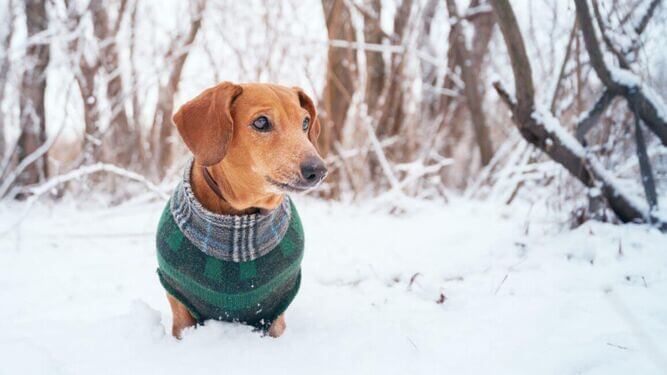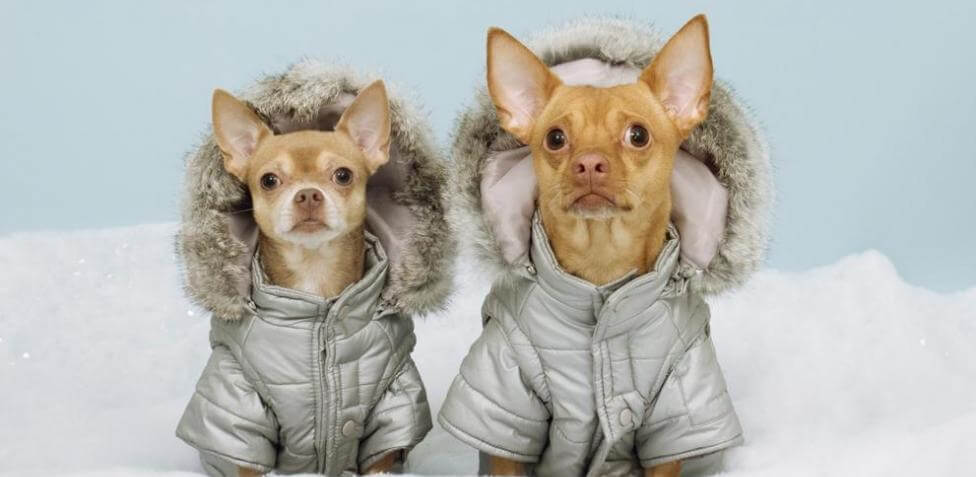Do Dogs Get Cold?


Written and verified by the veterinarian and zootechnician Sebastian Ramirez Ocampo
When the winter season arrives it’s normal for us to wonder if dogs get cold. The answer to this question may vary depending on the breed and build of our dog. Although their ancestors were very well adapted to low temperatures, today’s dogs don’t have the same characteristics as ancient wolves.
In addition to this, as they’re considered endothermic animals, that is, they can regulate their body temperature autonomously, dogs can feel cold depending on the type of skin and coat, as well as the environmental conditions they live in.
As we know how important the welfare of your pet is to you, we’re going to bring you valuable information to prevent your dog from having a bad time during the winter. Continue reading these lines and discover the best tips.
Do dogs feel cold?
As mentioned above, dogs are endothermic animals, so they can regulate their body temperature regardless of whether it’s cold or warm. However, this ability can be affected mainly by the dog’s physical characteristics.
For example, breeds that have a thick and abundant coat retain the heat generated by their body better, so they’re less susceptible to cold. The opposite is true for short-haired breeds, which are better adapted to warm climates.
Accordingly, dogs such as the Husky, the St. Bernard, or the Bernese have a greater resistance to low temperatures. On the other hand, Pinscher dogs, chihuahuas or greyhounds can suffer more from sudden changes in temperature.

On the other hand, it’s important to highlight that regardless of the breed of dog, there are some temperatures that are impossible for them to bear. According to the scientific article Hypothermia and targeted temperature management in cats and dogs, any adult dog can suffer from the cold. In addition, the document states that if our pet’s body temperature drops too much, it could be at risk of hypothermia.
How to identify if my dog is cold
There are many signs that can indicate if a dog is getting cold. On the one hand, as with humans, muscle movements known as “twitching” are the first action the body takes to try to warm up internally. Likewise, moving slowly is also an indication of cold in dogs, since muscles and joints are stiffened by low temperatures.
On the other hand, the areas of the body with less blood risk are the ones that tend to cool down first. Therefore, cold ears, nose, and pads are an indication that the dogs’ body temperature has dropped. Finally, oversleeping often occurs when they’re feeling cold. This is because the body seeks to expend as few calories as possible in movement, with the goal of using them to increase internal temperature.
How to avoid it
There are several strategies to help our pet to cope with low temperatures. Among the main ones we find the following:
- Coat: Especially in small breeds or those with little hair, clothing is very important. In this way, we will help him to keep his body temperature, besides protecting him from the frosts that can be generated in winter.
- Warm beds: We must prevent our pet from lying on the floor during cold weather. A well-padded bed, together with some blankets, may be enough to prevent our dog from getting cold.
- High-calorie foods: As stated in an article shared in the Journal of Applied Physiology, dogs need high levels of calories and carbohydrates to regulate their temperature in the winter. Therefore, try to get food that supplies these.
- Avoid cutting their hair: As described above, dogs with little hair tend to suffer more from low temperatures. For this reason, you should try not to cut it during the winter.

Cold-related complications
In certain cases, the cold can be quite harmful for our pets. On the one hand, due to low temperatures, dogs can develop respiratory diseases such as tracheobronchitis, pharyngitis, bronchitis, or even pneumonia.
On the other hand, according to a paper published in the Journal of Veterinary Internal Medicine, dogs with osteoarthritis, herniated discs, or dysplasia may experience increased joint pain due to the cold.
Now that you know how to identify the symptoms of a dog feeling cold and how to deal with it, it’s your duty to look after your pet’s well-being. Remember to keep your pet warm and provide them with all the necessary elements to maintain an adequate body temperature.
When the winter season arrives it’s normal for us to wonder if dogs get cold. The answer to this question may vary depending on the breed and build of our dog. Although their ancestors were very well adapted to low temperatures, today’s dogs don’t have the same characteristics as ancient wolves.
In addition to this, as they’re considered endothermic animals, that is, they can regulate their body temperature autonomously, dogs can feel cold depending on the type of skin and coat, as well as the environmental conditions they live in.
As we know how important the welfare of your pet is to you, we’re going to bring you valuable information to prevent your dog from having a bad time during the winter. Continue reading these lines and discover the best tips.
Do dogs feel cold?
As mentioned above, dogs are endothermic animals, so they can regulate their body temperature regardless of whether it’s cold or warm. However, this ability can be affected mainly by the dog’s physical characteristics.
For example, breeds that have a thick and abundant coat retain the heat generated by their body better, so they’re less susceptible to cold. The opposite is true for short-haired breeds, which are better adapted to warm climates.
Accordingly, dogs such as the Husky, the St. Bernard, or the Bernese have a greater resistance to low temperatures. On the other hand, Pinscher dogs, chihuahuas or greyhounds can suffer more from sudden changes in temperature.

On the other hand, it’s important to highlight that regardless of the breed of dog, there are some temperatures that are impossible for them to bear. According to the scientific article Hypothermia and targeted temperature management in cats and dogs, any adult dog can suffer from the cold. In addition, the document states that if our pet’s body temperature drops too much, it could be at risk of hypothermia.
How to identify if my dog is cold
There are many signs that can indicate if a dog is getting cold. On the one hand, as with humans, muscle movements known as “twitching” are the first action the body takes to try to warm up internally. Likewise, moving slowly is also an indication of cold in dogs, since muscles and joints are stiffened by low temperatures.
On the other hand, the areas of the body with less blood risk are the ones that tend to cool down first. Therefore, cold ears, nose, and pads are an indication that the dogs’ body temperature has dropped. Finally, oversleeping often occurs when they’re feeling cold. This is because the body seeks to expend as few calories as possible in movement, with the goal of using them to increase internal temperature.
How to avoid it
There are several strategies to help our pet to cope with low temperatures. Among the main ones we find the following:
- Coat: Especially in small breeds or those with little hair, clothing is very important. In this way, we will help him to keep his body temperature, besides protecting him from the frosts that can be generated in winter.
- Warm beds: We must prevent our pet from lying on the floor during cold weather. A well-padded bed, together with some blankets, may be enough to prevent our dog from getting cold.
- High-calorie foods: As stated in an article shared in the Journal of Applied Physiology, dogs need high levels of calories and carbohydrates to regulate their temperature in the winter. Therefore, try to get food that supplies these.
- Avoid cutting their hair: As described above, dogs with little hair tend to suffer more from low temperatures. For this reason, you should try not to cut it during the winter.

Cold-related complications
In certain cases, the cold can be quite harmful for our pets. On the one hand, due to low temperatures, dogs can develop respiratory diseases such as tracheobronchitis, pharyngitis, bronchitis, or even pneumonia.
On the other hand, according to a paper published in the Journal of Veterinary Internal Medicine, dogs with osteoarthritis, herniated discs, or dysplasia may experience increased joint pain due to the cold.
Now that you know how to identify the symptoms of a dog feeling cold and how to deal with it, it’s your duty to look after your pet’s well-being. Remember to keep your pet warm and provide them with all the necessary elements to maintain an adequate body temperature.
All cited sources were thoroughly reviewed by our team to ensure their quality, reliability, currency, and validity. The bibliography of this article was considered reliable and of academic or scientific accuracy.
- Brodeur A, Wright A, Cortes Y. Hypothermia and targeted temperature management in cats and dogs. Journal of veterinary emergency and critical care (San Antonio, Tex : 2001). 2017;27(2):151-63.
- Gorney AM, Blau SR, Dohse CS, Griffith EH, Williams KD, Lim JH, et al. Mechanical and Thermal Sensory Testing in Normal Chondrodystrophoid Dogs and Dogs with Spinal Cord Injury caused by Thoracolumbar Intervertebral Disc Herniations. Journal of veterinary internal medicine. 2016;30(2):627-35.
- Paul P, Donohue M, Holmes WL. Glucose metabolism in thyroidectomized and normal dogs during rest and acute cold exposure. Journal of applied physiology. 1975;38(2):236-40.
- Bigelow WG, Lindsay WK. Oxygen transport and utilization in dogs at low body temperatures. The American journal of physiology. 1950;160(1):125-37.
This text is provided for informational purposes only and does not replace consultation with a professional. If in doubt, consult your specialist.








